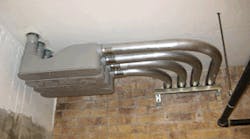Low-Voltage Pathways Can Be a Challenge
On a large renovation project of a seven-story apartment building, the owner engaged a construction management firm, which, in turn, bid out the electrical and telecommunications work separately. The electrical contractor that installed the low-voltage pathways was unaware that an offset in the conduit constituted a 90° bend. This was a problem, because low-voltage conduits are only allowed two 90° bends, according to the referenced standards and guidelines for the project. During the low-voltage supervisor’s initial site visit during construction, he immediately noticed the offsets. The electrical contractor was likely responsible for fixing all of those conduit runs or installing additional pullboxes in order to meet the contract documents.
Use of Smart LB conduit body allows a 90-degree
bend when there is not enough space for the long
radius sweep.
To avoid these types of mistakes, the well-informed electrical contractor should understand where these types of requirements are stipulated, because drawings and specifications may simply list referenced codes, standards, and guidelines that must be followed. The three primary references that govern low-voltage pathways are:
- The National Electrical Code (NFPA 70)
- Commercial Building Standard for Telecommunications Pathways and Spaces (TIA-569-B)
- The Telecommunications Distribution Methods Manual (TDMM) — a “best practices” guideline published by BICSI
In the NEC, one of the most important requirements affecting low-voltage pathways is the 50-ft rule. For the three major types of cable — optical fiber, communications circuits (copper), and community antenna television (CATV) — Sections 770.48, 800.48, and 820.48 all state the same thing. Unlisted cable serving the building, such as from a service provider, can only be routed in the building a maximum of 50 ft from the building entrance point before it has to be transitioned to an appropriately rated inside plant cable (such as riser or plenum). Referencing the definitions section for all three types of cables, the point of entrance is defined as: “The point within a building at which the cable emerges from an external wall, from a concrete floor slab, or from a rigid metal conduit (Type RMC) or an intermediate metal conduit (Type IMC) connected by a grounding conductor to an electrode” (in accordance with that section).
The best practice is for communications conduits to stub up directly into the main communications room. (This also makes it the communications “entrance facility.”) If that is not possible — or if the entrance facility is not on the ground level — then the unlisted cables must be routed through RMC or IMC to within 50 ft of where they terminate.
Another area of concern is the placement of communications outlets in slab-on-grade floor boxes. Because the NEC defines this application as a wet location (Art. 100), the owner or telecommunications contractor will likely use a wet-rated cable. Most wet-rated cables are unlisted for indoor use, meaning that they would have to follow the 50-ft rule as well. The contract documents may also stipulate that cables must be rated for the location where they are installed, which would require a plenum or riser-rated cable. A few manufacturers have developed products that are both plenum and wet-rated, but the electrical contractor may not always know in advance if that type of cable will be installed. To avoid this issue, it’s always best to extend the underground or in-slab conduit — for both floor boxes and any outlet outside — to the serving communication room and stub it up there, negating the 50-ft rule or rating requirement.
If the underground conduit run to the communications room proves too difficult or expensive to install, it is acceptable to stub it up at an adjacent wall that provides access to the accessible ceiling space. If it is known beforehand that a dual-rated cable will be installed, then the conduit can simply enter the ceiling space. However, if the type of cable is unknown or not rated for indoor use, then an enclosure (junction box or larger) is needed to transition from the wet-rated cable to plenum or riser-rated inside plant cable (click here to see Fig. 1).
The second document, the TIA-569-B standard, is a great reference for architects, engineers, and telecommunications designers, because it establishes basic specifications for communications rooms (spaces). The designer may follow the pathway recommendations from this standard in the design but may not indicate specific requirements on the construction documents. Oftentimes, you’ll see a line in the specifications stating that the TIA-569-B must be followed.
Some of the more important “recommendations,” which may potentially become requirements for your next project, include:
- Installation of a minimum of (3) 4-in. building entrance conduits — usually one for the telephone/Internet service provider, one for the CATV provider, and one spare.
- Lighting levels in any communications room are to be a minimum of 50 fc measured 3 ft above the floor. This will likely require you to coordinate the luminaire placement with equipment and rack layouts in each room — something the electrical or lighting designer may not have incorporated into their initial layout. Be sure you place the luminaires over the aisles and not over the equipment.
-
Installation of minimum outlet box sizes, which varies according to the size of the feeding conduit.
- ¾-in. conduit – minimum outlet box dimensions (2 in. × 3 in. × 2½ in. deep)
- 1-in. conduit – minimum outlet box dimensions (4 in. × 4 in. × 2¼ in. deep)
- 1¼-in. conduit – minimum outlet box dimensions (411/16 in. × 411/16 in. × 2½ in. deep)
Note: standard 21/8-in.-deep back boxes can likely be used to meet these requirements as long as the extension ring is deep enough so that the box’s overall depth meets the 2¼ -in. or 2½-in. requirement.
- The bend radius of conduits 2 in. and less is to be six times the diameter of the conduit. The bend radius for conduits greater than 2 in. must be 10 times the diameter of the conduit.
- A pullbox is needed between every 100 ft of conduit and between every two 90° bends (or equivalent).
- Pullboxes should be designed and placed so the cables do not change direction in the pullbox.
- Pullboxes should be sized as noted in the Table (click here to see Table).
The BICSI TDMM will also likely be referenced in the specifications by the telecommunications designer. While every effort was likely made to follow these best practices in the design, not all requirements are necessarily added to the construction drawings and specifications. Some of the more important guidelines from the TDMM include:
- An offset of a conduit constitutes a 90° bend.
-
Communications cables are to be separated from EMI sources exceeding 5kVA according to the following stipulations:
- 6-in. separation between communications conduit and power line conduit
- 12-in. separation between communications conduit and unshielded power lines or electrical equipment
- 24-in. separation between communications cables in j-hooks or cable tray and unshielded power lines or electrical equipment
- 46-in. separation from electrical motors and transformers
- The TDMM allows the use of special communications LB to make sharp 90° turns where there is not enough space to make the appropriate bend in the conduit (see Photo above). The new 12th edition also lists other special conduit bodies.
- For 1-in. conduits only, an appropriately sized pullbox (4 in. × 16 in. × 3 in.) can be replaced with a 4-in. × 4-in. junction box.
Although the guidelines noted in the three primary references above cover most installation issues you’ll run across, there are a few other best practices you should follow.
Because new buildings today have a lifespan of 50 yr or more, it might be best to future-proof the conduit serving a typical communications outlet. For example, a ¾-in. conduit may be able to serve at most one or two of today’s Cat. 6A cables. However, installation of a 1-in. or 1¼-in. conduit would allow for future growth and better serve your customer.
In addition, outlets with audio/video connections should really be extra deep (3½ in.) with a minimum of 1½-in. conduit (click here to see Fig. 2). This will allow the owner or AV integrator to pull a pre-terminated VGA cable through a 1½-in. conduit and make the bend in the back of the box to the faceplate. Manufacturers stipulate a minimum bend radius of four times the diameter of the cable, and some VGA cables are nearly 0.5 in. in diameter.
Low or zero-maintenance firestop assemblies should be considered for communications conduit sleeves through fire-rated walls. The use of putty, pillows, and pads makes it more difficult for the owner or building occupant to reuse those pathways for moves, adds, and changes.
Other standards and guidelines which may be referenced in construction specifications include:
- NECA/BICSI-568-2006 Standard for Installing Commercial Building Telecommunications Cabling
- BICSI Information Transport Systems Installation Methods Manual
- BICSI Customer-Owned Outside Plant Design Manual
- NEMA VE 2-2000, Cable Tray Installation Guidelines
Peterworth works in the Information Technology Services - Networking & Telecommunications department at the University of Texas at Austin in Austin, Texas. He can be reached at: [email protected].



